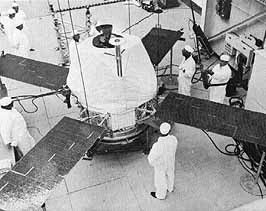|
Table 28 [whole page 171]
|
|
Major Test and Flight
Hardware to be Developed by JPL for the Viking
Orbiter
|
|
|
|
|
|
Scheduled Delivery
Dates
|
|
Equipment
|
Purpose or Function of
Equipment
|
As of 10 Feb. 1969
|
As of 13 Mar. 1969
|
As of 7 Aug. 1969
|
|
|
|
|
|
|
|
Orbiter structural test model
(STM)
|
Also called development test Model
(DTM). For qualification testing of basic orbiter
structure, including vibration, static modal, and
separation of orbiter from lander tests
|
mid-Feb.1971
|
15 Sept.1971
|
15 Aug.1971
|
|
|
|
Thermal Control test model
(TCM)
|
Tear For thermal qualifications of
orbiter systems. During tests, TCM to be mated with
lander capsule thermal effects simulator to test effects
on orbiter of lander heating. Both STM and TCM to be
returned to JPL by 1 Aug. 1971 for laboratory
testing.
|
1 Mar. 1971
|
1 Dec. 1970
|
1 July 1971
|
|
|
|
Engineering test model
(ETM)
|
To validate physical and
functional interfaces between orbiter and lander capsule
and between spacecraft and people, procedures, and
facilities associated with combined systems tests. To be
assembled from early production components for orbiter;
flight-qualified parts not necessary. Could be updated
after tests for use in Deep Space Network compatibility
testing and launch center testing.
|
1 Aug. 1971
|
1 Dec. 1971
|
1 Feb. 1972
|
|
|
|
Proof-test model (PYM)
|
To demonstrate orbiter design
adequacy by performance of qualification tests, including
vibration, shock, and thermal/vacuum. Also to be used for
propulsion-system-interaction tests.
|
1 Feb. 1972
|
15 July 1972
|
1 Aug. 1972
|
|
|
|
Flight orbiters
|
Three flight-ready orbiters to be
fabricated by JPL, two to be launched, and third to be
held as backup before launch and as systems test vehicle
during mission.
|
1 Aug. 1972
1 Sept. 1972
1 Oct. 1972
|
15 Oct. 1972
15 Nov. 1972
15 Dec. 1972
|
1 Jan. 1973
1 Feb.1973
1 Mar. 1973
|
















